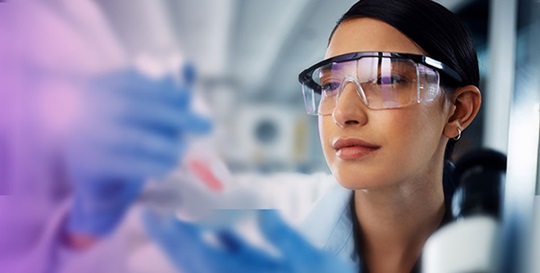Laboratories have evolved throughout the 20th and 21st centuries. From staffing levels and personnel requirements to technological advancements, many aspects of today’s labs look markedly different than they did in decades past.1 However, one activity has remained a top priority: maintenance.
Laboratory Maintenance is Essential
Proper maintenance is fundamental to supporting accuracy and quality of results.2 In the list of medical activities, laboratory diagnostic testing ranks first for volume. The results of those tests influence approximately 70% of interactions between physicians and patients—so proper function of equipment and analyzers is ultimately imperative for patient safety. What’s more, performing routine maintenance has been shown to help improve turnaround time (TAT) and cost savings.3
Every minute of instrument downtime may represent lost revenue, interrupted service, and most importantly, delayed test results. Proper maintenance is vital to support timely patient care, prolong the life of capital investments, and reduce costly repairs.
The Evolution of Laboratory Maintenance
Historically, the practice of maintaining equipment in a lab was a reactive activity: instruments were used until they failed or degraded enough to require repair, replenishment, or cleaning. However, as instruments have become more complex, maintenance models have evolved along with them:4
Preventive Maintenance
This philosophy centers on working to delay or prevent equipment failure by replacing or repairing parts before they break or degrade.2 Documentation of these practices is important not only to maximize system performance, but also to support contingency plans in the event of emergencies like extended power outages.5 This practice is still prominent today, but its power is limited. For example, studies have shown that the act of maintenance itself can introduce risk of failure.2 Therefore, preventive maintenance is an important practice—but not a complete solution on its own.2
Reliability-Centered Maintenance
This model assumes that equipment failure is inevitable. Instead of trying to prevent it, it focuses on contingency plans to preserve essential functions. This involves identifying and ranking failure modes, then working to mitigate the most impactful modes.2 The goal is maximizing facility and equipment reliability while minimizing life-cycle costs.6
Predictive Maintenance
An advanced practice within reliability-centered maintenance, this practice uses technological monitoring to determine a laboratory’s maintenance needs based on performance/system status monitoring rather than a set schedule (e.g., monitoring equipment wear). Some may find the technology needed for this type of monitoring too expensive for smaller, low-volume equipment.2 However, it has been shown to decrease costs by 10-40%.7
Total Productive Maintenance
The goal of this approach is to improve both system function and employee satisfaction.8 Total Productive Maintenance incorporates elements of all the models above, while recognizing the importance of the laboratory personnel in prioritizing and carrying out equipment maintenance. It assumes that anyone who interacts with a clinical laboratory’s equipment should play a role in its maintenance; thus, its reliability should improve over time rather than degrade.2
Whatever model (or models) a lab subscribes to, maintenance is certainly an important part of its workflow. Depending on the equipment and timing, that maintenance can take many forms.
Types of Laboratory Maintenance
Maintenance activities vary based on equipment type, time, and more. Taking an immunoassay analyzer as an example, some maintenance tasks for laboratory staff may include:
Daily Maintenance
- Sample activities:
- Check water supply and waste drains
- Daily instrument clean
- Daily probe cleaning routine
- System priming
- Sample time requirement: 10-12 minutes of downtime*
Weekly Maintenance
- Sample activities:
- Swap out and decontaminate components like water bottles
- Reagent and aspirate probe cleaning routine
- System clean routine
- Clean fan filters
- Sample time requirement: 15 minutes of downtime*
Monthly Maintenance
- Sample activities:
- Clean water tanks & filters
- Clean air filters
- Inspect pump connections
- Inspect and clean reagent and aspirate pipettors
- System clean routine
- Replace tubing
- Sample time requirement: >30 minutes of downtime*
* Estimates only; times may vary.
Why is Maintenance Often Difficult to Prioritize?
Laboratorians are being pushed to new limits as they struggle with testing surges, supply shortages, and staffing issues.9–14 Understandably, when it comes to laboratory maintenance, laboratory staff has many other responsibilities competing for limited time.
Even for labs with multiple analyzers, taking one instrument offline for maintenance can feel risky. Labs can plan and prepare for peak volume when all instruments are online. However, when one is offline, it can feel like a race against the clock to bring it back online before the other experiences an issue that could impact the lab’s ability to produce results.
How Can Busy Labs Prioritize Maintenance?
Industry experts cite several ways to optimize laboratory maintenance, along with key technology features that can help.
- Prioritize Training
Especially in light of staffing shortages and less skilled personnel, it’s critical to prioritize training on each instrument and its maintenance requirements.14 Technology vendors should provide specialized training, whether on site or remote. Even better, look for instrument-guided workflows that partner with users of all skill levels, instructing them clearly on what to do and when. - Select Instruments That Automate Routine Maintenance Tasks
Some instruments can handle routine maintenance tasks on their own, without operator intervention, removing work from your staff’s plates and creating time for them to focus on what matters most. Ask your equipment providers about daily, weekly, and monthly maintenance requirements up front, and find the right cadence for your lab. - Use Onboard Guides Designed to Simplify Maintenance Tasks
Save time and reduce potential for error during maintenance. Instead of relying on physical user manuals or time-consuming calls to support lines, look for instruments that will walk you through maintenance activities with step-by-step instructions, graphics, and videos.
Over time, the tasks associated with laboratory maintenance have changed greatly, but its importance has never faltered. That’s why today’s busy laboratorians are turning to clinical lab equipment to handle much of it—so they can focus on what matters most and keep their labs running efficiently.
Learn how the DxI 9000 Access Immunoassay Analyzer helps you create time for what matters most with ZeroDaily Maintenance

 English
English





